This is a nice little publication that gives a quick run down of positive (and some negative) uses of PMC’s over the years. One of the conclusions made, that I really like, is the concept of applying quality control and clear objectives for these companies. The author makes the point that if used correctly, PMC’s are certainly capable of producing excellent results (Executive Outcomes in Sierra Leone for example). If there is no clear oversight or clear objective for these companies, then that is when problems arise (like in Iraq or Afghanistan).
To me, this conversation needs to continue to happen in this industry, of where we are and where we have come from, so we know best how to carry on into the future. All of the companies and the clients that use us must become the ultimate learning organizations and continue to find a better way. There is too much at stake in this war to not care about doing it right. It is also the goal of Feral Jundi to present to the reading public that we in this industry do care, and with a lot of hard work and persistence, we can find a better way.
The most important aspect of this conversation are the ideas that each side of the debate uses to support their views. For to long, academia and media has hijacked these ideas with assumptions and half-truths, and the only way to stop that is to challenge those assumptions with solid facts to the contrary. To be silent and not challenge this ideas only allows these assumptions to become some kind of truth.
And this site is not some propaganda machine (privately owned and operated by me, and not some company blog), that supports some ‘military industrial complex conspiracy’. This site is about setting the record straight, and having a serious discussion about the use of this tool called the ‘private security contractor’ in today’s war. I have been critical of this industry and of the client here before on FJ, only with the goal of presenting ideas for fixing the problems and providing a better service for the client–not promoting the shutting down of the whole thing down.
Identify the problems, identify the industry we want, and find the correct models and systems out there for contracting and oversight that will only help us to achieve that goal. I think we are doing great at identifying the problems, but we still have a ways to go on figuring out what is ‘the industry we want’. And I say ‘we’ meaning the state. It’s not about what I want, or what the government wants, but what the state collectively wants and what they are comfortable with. It does matter what the professor or the soccer mom or whomever thinks about this industry, and the more we can work to explain and justify what we are and what we can do for the people and the government in today’s war, the better it is for all. –Matt
——————————————————————
Efficacy of Private Military Contractors in Peace Operations
By: Nicholas Pascucci
Date: December 5, 2008
Summary: The Private Military Contracting field has experienced massive growth since the September 11th attacks. This essay explores how the contractors have been used in the past and how they can be used in peace- and nation-building operations in the future.
Introduction
In the years since the September 11, 2001 attacks, the Private Military and Security industries have grown remarkably, garnering contracts in hotspots and warzones around the world in support of the interests of both nation states and private companies. Private Military Companies can be found in over 50 countries, operating in an industry that makes over one hundred billion dollars annually.1 Their increased use has sparked much controversy, and revelations regarding both the successes and failures of the industry raise questions about its role in moderating conflict worldwide. In an industry whose primary focus is providing military-related services in failed states and conflict areas, understanding the effects of their activities and presence in those areas is essential to being able to utilize them effectively in creating peace.

